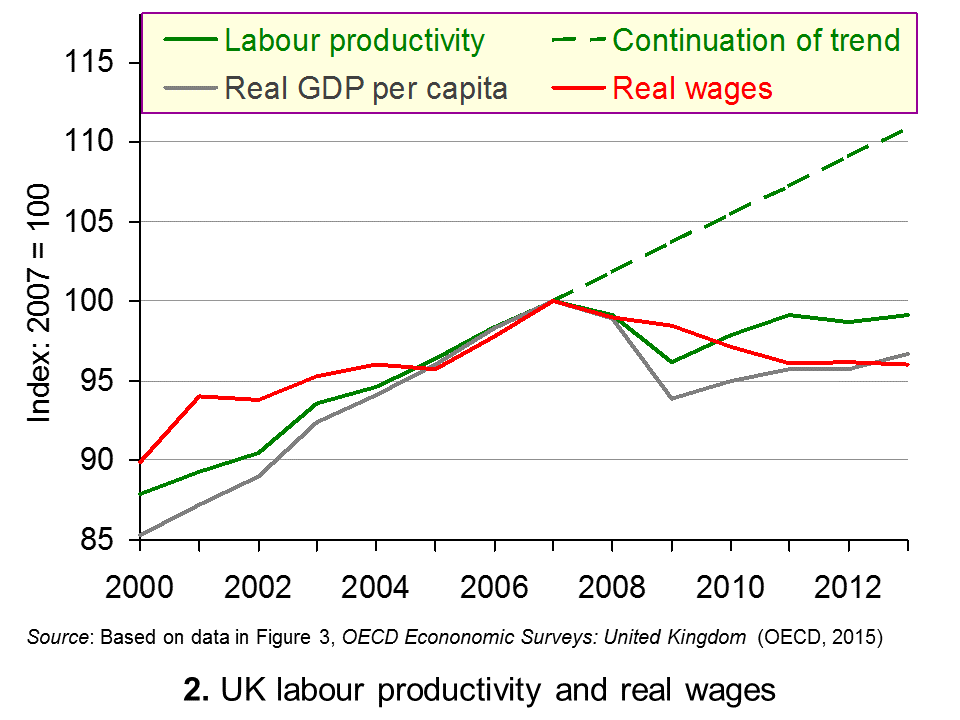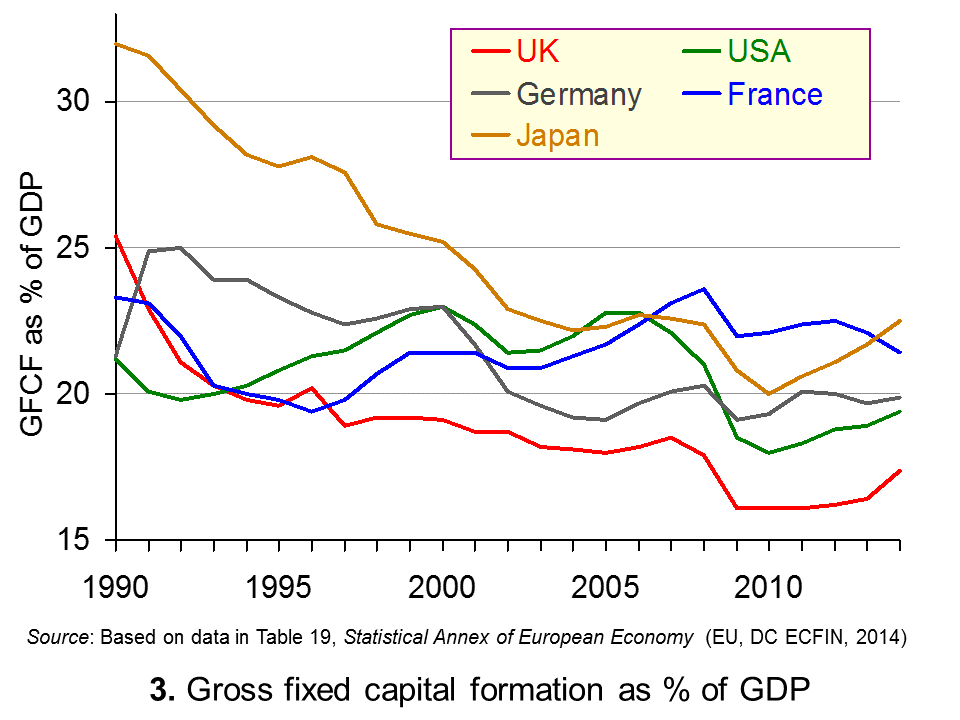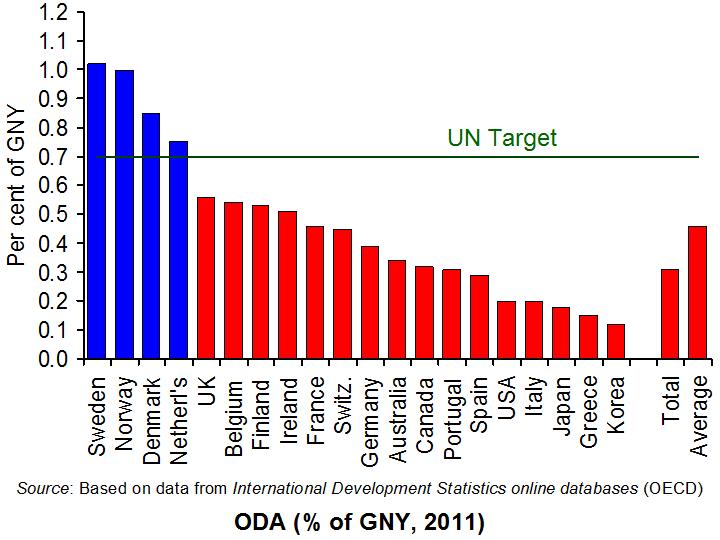 First the IMF in its World Economic Outlook, then the European Commission in its Economic Forecasts (see also) and now the OECD in its Economic Outlook (see also) – all three organisations in the latest issues of their 6-monthly publications are predicting slower global economic growth than they did 6 months previously. This applies both to the current year and to 2016. The OECD’s forecast for global growth this year is now 2.9%, down from the 3.7% it was forecasting a year ago. Its latest growth forecast for 2016 is 3.3%, down from the 3.9% it was forecasting a year ago.
First the IMF in its World Economic Outlook, then the European Commission in its Economic Forecasts (see also) and now the OECD in its Economic Outlook (see also) – all three organisations in the latest issues of their 6-monthly publications are predicting slower global economic growth than they did 6 months previously. This applies both to the current year and to 2016. The OECD’s forecast for global growth this year is now 2.9%, down from the 3.7% it was forecasting a year ago. Its latest growth forecast for 2016 is 3.3%, down from the 3.9% it was forecasting a year ago.
Various reasons are given for the gloomier outlook. These include: a dramatic slowdown in global trade growth; slowing economic growth in China and fears over structural weaknesses in China; falling commodity prices (linked to slowing demand but also as a result of increased supply); austerity policies as governments attempt to deal with the hangover of debt from the financial crisis of 2007/8; low investment leading to low rates of productivity growth despite technological progress; and general fears about low growth leading to low spending as people become more cautious about their future incomes.
 The slowdown in trade growth (forecast to be just 2% in 2015) is perhaps the most worrying for future global growth. As Angel Gurría, OECD Secretary-General, states in his remarks at the launch of the latest OECD Economic Outlook:
The slowdown in trade growth (forecast to be just 2% in 2015) is perhaps the most worrying for future global growth. As Angel Gurría, OECD Secretary-General, states in his remarks at the launch of the latest OECD Economic Outlook:
‘Global trade, which was already growing slowly over the past few years, appears to have stagnated and even declined since late 2014, with the weakness centering increasingly on emerging markets, particularly China. This is deeply concerning as robust trade and global growth go hand in hand. In 2015 global trade is expected to grow by a disappointing 2%. Over the past five decades there have been only five other years in which trade growth has been 2% or less, all of which coincided with a marked downturn of global growth.’
So what policies should governments pursue to stimulate economic growth? According to Angel Gurría:
‘Short-term demand needs to be supported and structural reforms to be pursued with greater ambition than is currently the case. Three specific actions are key:
|
|
| • |
First, we need to resist and turn back rising protectionism. Trade strengthens competition and investment and revs up the “diffusion machine” – the spread of new technologies throughout the economy – which will ultimately lift productivity. |
| • |
Second, we need to step up structural reform efforts, which have weakened in recent years. And here, I mean the whole range of structural reforms – education, innovation, competition, labour and product market regulation, R&D, taxes, etc. |
| • |
Third, there is scope to adjust public spending towards investment. If done collectively by all countries, if the sector and projects chosen have high multipliers, and if combined with serious structural reforms, stronger public investment can give a boost to growth and employment and not increase the relative debt burden.’ |
 On this third point, the OECD Economic Outlook argues that ‘the rationale for such investments is that they could help to push economies onto a higher growth path than might otherwise be the case, at a time when private investment growth remains modest.’
On this third point, the OECD Economic Outlook argues that ‘the rationale for such investments is that they could help to push economies onto a higher growth path than might otherwise be the case, at a time when private investment growth remains modest.’
‘Collective action to increase public investment can be expected to boost the initial domestic multiplier effects from the stimulus, since private investment and exports in each economy will benefit from stronger demand in other economies. …the multiplier effects from an investment-led stimulus are likely to be a little larger than from other forms of fiscal stimulus, since the former also has small, but positive, supply-side effects.
In other words, the OECD is calling for a relaxation of austerity policies, with public investment being used to provide a stimulus to growth. The higher growth will then lead to increased potential output, as well as actual output, and an increase in tax revenues.
These policy recommendations are very much in line with those of the IMF.
Videos and Webcasts
 OECD warns of global trade slowdown, trims growth outlook again Reuters (9/11/15)
OECD warns of global trade slowdown, trims growth outlook again Reuters (9/11/15)
 OECD returns to revisionism with growth downgrade Euronews, Robert Hackwill (9/11/15)
OECD returns to revisionism with growth downgrade Euronews, Robert Hackwill (9/11/15)
 OECD: Weak China Import Growth Leads Trade Slowdown Bloomberg, Catherine L Mann, OECD Chief Economist (9/11/15)
OECD: Weak China Import Growth Leads Trade Slowdown Bloomberg, Catherine L Mann, OECD Chief Economist (9/11/15)
 OECD Economic Outlook: Moving forward in difficult times OECD PowerPoint presentation, Catherine L Mann, OECD Chief Economist (9/11/15)
OECD Economic Outlook: Moving forward in difficult times OECD PowerPoint presentation, Catherine L Mann, OECD Chief Economist (9/11/15)
 Press Conference OECD, Angel Gurría and Álvaro Pereira (9/11/15)
Press Conference OECD, Angel Gurría and Álvaro Pereira (9/11/15)
Articles
OECD cuts world growth forecast Financial Times, Ferdinando Giugliano (9/11/15)
OECD rings alarm bell over threat of global growth recession thanks to China slowdown Independent, Ben Chu (10/11/15)
OECD cuts global growth forecasts amid ‘deep concern’ over slowdown BBC News (9/11/15)
OECD fears slowdown in global trade amid China woes The Guardian, Katie Allen (9/11/15)
The global economy is slowing down. But is it recession – or protectionism? The Observer, Heather Stewart and Fergus Ryan (14/11/15)
Global growth is struggling, but it is not all bad news The Telegraph, Andrew Sentance (13/11/15)
OECD Publications
Economic Outlook Annex Tables OCED (9/11/15)
Press Release: Emerging market slowdown and drop in trade clouding global outlook OCED (9/11/15)
Data handout for press OECD (9/11/15)
OECD Economic Outlook, Chapter 3: Lifting Investment for Higher Sustainable Growth OCED (9/11/15)
OECD Economic Outlook: Full Report OECD (9/11/15)
Questions
- Is a slowdown in international trade a cause of slower economic growth or simply an indicator of slower economic growth? Examine the causal connections between trade and growth.
- How worried should we be about disappointing growth in the global economy?
- What determines the size of the multiplier effects of an increase in public investment?
- Why are the multiplier effects of an increase in public-sector investment likely to be larger in the USA and Japan than in the UK, the eurozone and Canada?
- How can monetary policy be supportive of fiscal policy to stimulate economic growth?
- Under what circumstances would public-sector investment (a) stimulate and (b) crowd out private-sector investment?
- How would a Keynesian economist respond to the recommendations of the OECD?
- How would a neoclassical/neoliberal economist respond to the recommendations?
- Are the OECD’s recommendations in line with the Japanese government’s ‘three arrows‘?
- What structural reforms are recommended by the OECD? Are these ‘market orientated’ or ‘interventionist’ reforms, or both? Explain.
 ‘Employment has been strong, but productivity and real wages have been flat.’ This is one of the key observations in a new OECD report on the state of the UK economy. If real incomes for the majority of people are to be raised, then labour productivity must rise.
‘Employment has been strong, but productivity and real wages have been flat.’ This is one of the key observations in a new OECD report on the state of the UK economy. If real incomes for the majority of people are to be raised, then labour productivity must rise.
For many years, the UK has had a lower productivity (in terms of output per hour worked) than most other developed countries, with the exception of Japan. But from 1980 to the mid 2000s, the gap was gradually narrowing. Since then, however, the gap has been widening again. This is illustrated in Chart 1, which shows countries’ productivity relative to the UK’s (with the UK set at 100). (Click here for a PowerPoint.)
Compared with the UK, GDP per hour worked in 2013 (the latest data available) was 28% higher in France, 29% higher in Germany and 30% higher in the USA. What is more, GDP per hour worked  and GDP per capita in the UK fell by 3.8% and 6.1% respectively after the financial crisis of 2007/8 (see the green and grey lines in Chart 2). And while both indicators began rising after 2009, they were still both below their 2007 levels in 2013. Average real wages also fell after 2007 but, unlike the other two indicators, kept on falling and by 2013 were 4% below their 2007 levels, as the red line in Chart 2 shows. (Click here for a PowerPoint.)
and GDP per capita in the UK fell by 3.8% and 6.1% respectively after the financial crisis of 2007/8 (see the green and grey lines in Chart 2). And while both indicators began rising after 2009, they were still both below their 2007 levels in 2013. Average real wages also fell after 2007 but, unlike the other two indicators, kept on falling and by 2013 were 4% below their 2007 levels, as the red line in Chart 2 shows. (Click here for a PowerPoint.)
Although productivity and even real wages are rising again, the rate of increase is slow. If productivity is to rise, there must be investment.  This could be in physical capital, human capital or, preferably, both. But for many years the UK has had a lower rate of investment than other countries, as Chart 3 shows. (Click here for a PowerPoint.) This chart measures investment in fixed capital as a percentage of GDP.
This could be in physical capital, human capital or, preferably, both. But for many years the UK has had a lower rate of investment than other countries, as Chart 3 shows. (Click here for a PowerPoint.) This chart measures investment in fixed capital as a percentage of GDP.
So how can investment be encouraged? Faster growth will encourage greater investment through the accelerator effect, but such an effect could well be short-lived as firms seek to re-equip but may be cautious about committing to increasing capacity. What is crucial here is maintaining  high degrees of business confidence over an extended period of time.
high degrees of business confidence over an extended period of time.
More fundamentally, there are structural problems that need tackling. One is the poor state of infrastructure. This is a problem not just in the UK, but in many developed countries, which cut back on public and private investment in transport, communications and energy infrastructure in an attempt to reduce government deficits after the financial crisis. Another is the low level of skills of many workers. Greater investment in training and apprenticeships would help here.
Then there is the question of access to finance. Although interest rates are very low, banks are cautious about granting long-term loans to business. Since the financial crisis banks have become much more risk averse and long-term loans, by their nature, are relatively risky. Government initiatives to provide finance to private companies may help here. For example the government has just announced a Help to Grow scheme which will provide support for 500 small firms each year through the new British Business Bank, which will provide investment loans and also grants on a match funding basis for new investment.
Articles
OECD: UK must fix productivity Economia, Oliver Griffin (25/2/15)
The UK’s productivity puzzle BBC News, Lina Yueh (24/2/15)
OECD warns UK must fix productivity problem to raise living standards The Guardian, Katie Allen (24/2/15)
Britain must boost productivity to complete post-crisis recovery, says OECD International Business Times, Ian Silvera (24/2/15)
OECD urges UK to loosen immigration controls on skilled workers Financial Times, Emily Cadman and Helen Warrell (24/2/15)
Report
OECD Economic Surveys, United Kingdom: Overview OECD (February 2015)
OECD Economic Surveys, United Kingdom: Full report OECD (February 2015)
Questions
- In what ways can productivity be measured? What are the relative merits of using the different measures?
- Why has the UK’s productivity lagged behind other industrialised countries?
- What is the relationship between income inequality and labour productivity?
- Why has UK investment been lower than in other industrialised countries?
- What are zombie firms? How does the problem of zombie firms in the UK compare with that in other countries? Explain the differences.
- What policies can be pursued to increased labour productivity?
- What difficulties are there in introducing effective policies to tackle low productivity?
- Should immigration controls be lifted to tackle the problem of a shortage of skilled workers?
 Many rich countries have made repeated commitments to the United Nations to give at least 0.7% of their gross national income (GNY) as international aid – or ‘official development assistance (ODA)’ as it is known. The first such commitments were made in 1970. Despite this, many of these countries’ aid to developing countries falls well short of the target.
Many rich countries have made repeated commitments to the United Nations to give at least 0.7% of their gross national income (GNY) as international aid – or ‘official development assistance (ODA)’ as it is known. The first such commitments were made in 1970. Despite this, many of these countries’ aid to developing countries falls well short of the target.
In fact the average amount given in aid in 2011 by the 23 donor countries which are members of the OECD’s Development Assistance Committee (DAC) was a mere 0.31% of GNY, with the USA, the biggest donor in absolute terms, giving only 0.2% of GNY. (Click here for a PowerPoint of the chart.) Since 2003, the DAC average has been 0.29% as compared with 0.30% between 1970 and 2002.
 In 2005, at the Gleneagles G8 summit, the 15 members of the EU which are Development Assistance Committee members committed themselves to reaching an ODA target of 0.51% of GNY in 2010 and to reach the 0.7% target by 2015. In 2011, the UK’s ODA/GNY ratio stood at 0.56% and so was above the EU target.
In 2005, at the Gleneagles G8 summit, the 15 members of the EU which are Development Assistance Committee members committed themselves to reaching an ODA target of 0.51% of GNY in 2010 and to reach the 0.7% target by 2015. In 2011, the UK’s ODA/GNY ratio stood at 0.56% and so was above the EU target.
Section 18 of the Coalition agreement pledges that the UK government will meet the 0.7% target by 2013 – a pledge initially made by the Labour government. So far, the government has stuck to this pledge and the aid budget has escaped cuts.
But with other parts of government expenditure facing cuts, pressure is mounting on the government to reduce the aid budget. There are two main parts to the argument. The first is that aid should face its ‘fair share’ of the cuts. The second is that aid is often an inefficient way of tackling poverty in developing countries and, when discussing aid, the focus should be on getting value for money rather than on the simple total amount of aid.
The following articles look at arguments for and against meeting aid targets and examine ways of making aid ‘smarter’.
Articles
Money may be tight, but ‘smart aid’ to developing countries can really work The Guardian, Larry Elliott (13/1/13)
International aid, but not as we know it The Guardian, Andy Sumner and Richard Mallett (31/12/12)
One in four support Britain’s foreign aid policies The Telegraph, Ben Leach (29/12/12)
Why is so much UK aid money still going to companies based in Britain? The Guardian, Claire Provost and Nicola Hughes (21/9/12)
Is the 0.7% aid target still relevant? The Guardian, Niels Keijzer (2/8/12)
What’s wrong with foreign aid? The Spectator (3/1/13)
Five reasons to deliver and legislate on international aid bond, UKAN (6/12)
The Political Economy of Bilateral Foreign Aid Working Knowledge, Harvard Business School, Eric D. Werker (4/1/13)
Misconceptions about aid Dawn (Pakistan), Niaz Murtaza (8/1/13)
Why political short-sightedness and randomised control trials can be a deadly mix for aid effectiveness Vox EU, Anders Olofsgård (13/10/12)
Aid in troubled times DfID, Paul Collier (2/7/12)
Data and information
Aid Effectiveness data World Bank
Aid statistics OECD
Aid effectiveness OECD
Aid Wikipedia
Questions
- What was agreed at the Gleneagles G8 summit?
- Examine the argument that aid crowds out private investment.
- Compare the relative benefits of tied and untied aid.
- Give some examples of ‘smart aid’.
- How would you establish whether or not it is ‘fair’ to cut the aid budget?
- Give three arguments for maintaining the aid budget and three arguments for cutting it. On which side do you come down and why?
If you are lucky enough to have piles of money earning interest in a bank account, one thing you don’t want to be doing is facing the dreaded tax bill on the interest earned. It is for this reason that many wealthy people put their savings into bank accounts in Switzerland and other countries with strict secrecy laws. Countries, such as Liechtenstein, Switzerland, Andorra, Liberia and the Principality of Monaco have previously had laws in place to prevent the effective exchange of information. This had meant that you could keep your money in an account there and the UK authorities would be unable to obtain any information for their tax records.
However, as part of an ongoing OECD initiative against harmful tax practices, more and more countries have been opening up to the exchange of information. In recent developments, Switzerland and the UK have signed an agreement, which will see them begin to negotiate on improving information exchange. In particular, the UK will be looking at the possibility of the Swiss authorities imposing a tax on any interest earned in their accounts by UK residents. This tax would be on behalf of HM Revenue and Customs. One concern, however, with this attempted crack down on tax evasion is that ‘innocent’ taxpayers could be the ones to suffer.
The following articles consider this recent development. It is also a good idea to look at the following link, which takes you to the OECD to view some recent agreements between the UK and other countries with regard to tax policy and the exchange of information. (The OECD)
Articles
UK in talks over taxing Britons’ Swiss bank accounts BBC News (26/10/10)
Doubts on plans to tackle tax evasion Telegraph, Myra Butterworth (21/10/10)
HMRC letters target taxpayers with Swiss bank accounts BBC News (25/10/10)
Spending Review: Can the taxman fix the system? BBC News, Kevin Peachey (22/10/10)
Britain, Switzerland agree to begin tax talks AFP (26/10/10)
Treasury to get £1 billion windfall in Swiss deal over secret bank accounts Guardian, Phillip Inman (26/10/10)
Swiss to help UK tax secret accounts Reuters (25/10/10)
Reports
The OECD’s Project on Hamful Tax Practices, 2006 Update on Progress in Member Countries The OECD, Centre for Tax Policy and Administration 2006
A Progress Report on the Jurisdictions surveyed by the OECD global forum in implementing the internationally agreed tax standard The OECD, Centre for Tax Policy and Administration (19/10/10)
Questions
- Is there a difference between tax avoidance and tax evasion?
- If there is crack down on tax evasion, what might be the impact on higher earners? How could this potential policy change adversely affect the performance of the UK economy?
- If tax evasion is reduced, what are the likely positive effects on everyday households?
- Is clamping down on tax evasion cost effective?
- What might be the impact on people’s willingness to work, especially of those on higher wages, if there is no longer a ‘haven’ where they can save their money?
- How could tax reform help the UK reduce its budget deficit?
In the UK, we have an inflation target of 2% and it’s the Bank of England’s job to use monetary policy, in particular interest rates, to keep inflation within 1 percentage point of its target. However, with rising commodity prices and the onset of recession back in 2008, interest rates had another objective: to prevent or at least lessen the recession. Bank Rate fell to 0.5% and there it has remained in a bid to encourage investment, discourage saving and increase consumption, as a means of stimulating the economy.
However, at such a low rate, interest rates are not acting as a brake on inflation, which is now well above target. This rise in inflation, has been largely brought about by cost-push factors, such as the restoration of the 17.5% VAT (up from the temporary 15%), higher oil and commodity prices, and a fall in the exchange rate. But part of the reason might be found in the increase in money supply that resulted from quantitative easing.
There are concerns that the UK may lose its credibility on inflation if action isn’t taken. The OECD has advised the Bank of England to raise Bank Rate to 3.5% by the end of 2011. The following articles consider this issue.
Articles
Time to worry about inflation? BBC News blogs, Stephanomics, Stephanie Flanders (28/5/10)
UK must not fall for the false promise of higher inflation Telegraph, Charles Bean, Deputy Governor of the Bank of England (4/6/10)
Reports and documents
General Assessment of the Macroeconomic Situation OECD Economic Outlook, No. 87 Chapter 1 (see especially pages 53–4) (May 2010)
United Kingdom – Country Summary OECD Economic Outlook, No. 87 (May 2010)
Statistical Annex OECD Economic Outlook, No. 87 (available 10/6/10)
Inflation Report portal Bank of England (see May 2010)
Questions
- Explain the relationship between interest rates and inflation. Why have such low interest rates caused inflation to increase?
- In 2008, the UK moved into recession, but was also suffering from inflation. This was unusual, as AD/AS analysis suggests that when aggregate demand falls, growth will fall, but so will prices. What can explain the low growth and inflation we saw in 2008?
- What is the difference between real and nominal GDP?
- What are the causes of the current high inflation and what solutions are available and viable?
- Why are expectations of inflation so important and how might they influence the Bank of England’s plans for interest rates?
- Do you think the OECD should have advised the Bank of England? Will there be any adverse effects internationally if the UK doesn’t heed the OECD’s advice?
- Is the OECD’s assessment of the UK in the above Country Summary consistent with its view on UK interest rates contained in pages 53 and 54 in the first OECD link?
 First the IMF in its World Economic Outlook, then the European Commission in its Economic Forecasts (see also) and now the OECD in its Economic Outlook (see also) – all three organisations in the latest issues of their 6-monthly publications are predicting slower global economic growth than they did 6 months previously. This applies both to the current year and to 2016. The OECD’s forecast for global growth this year is now 2.9%, down from the 3.7% it was forecasting a year ago. Its latest growth forecast for 2016 is 3.3%, down from the 3.9% it was forecasting a year ago.
First the IMF in its World Economic Outlook, then the European Commission in its Economic Forecasts (see also) and now the OECD in its Economic Outlook (see also) – all three organisations in the latest issues of their 6-monthly publications are predicting slower global economic growth than they did 6 months previously. This applies both to the current year and to 2016. The OECD’s forecast for global growth this year is now 2.9%, down from the 3.7% it was forecasting a year ago. Its latest growth forecast for 2016 is 3.3%, down from the 3.9% it was forecasting a year ago. The slowdown in trade growth (forecast to be just 2% in 2015) is perhaps the most worrying for future global growth. As Angel Gurría, OECD Secretary-General, states in his remarks at the launch of the latest OECD Economic Outlook:
The slowdown in trade growth (forecast to be just 2% in 2015) is perhaps the most worrying for future global growth. As Angel Gurría, OECD Secretary-General, states in his remarks at the launch of the latest OECD Economic Outlook: On this third point, the OECD Economic Outlook argues that ‘the rationale for such investments is that they could help to push economies onto a higher growth path than might otherwise be the case, at a time when private investment growth remains modest.’
On this third point, the OECD Economic Outlook argues that ‘the rationale for such investments is that they could help to push economies onto a higher growth path than might otherwise be the case, at a time when private investment growth remains modest.’ OECD warns of global trade slowdown, trims growth outlook again Reuters (9/11/15)
OECD warns of global trade slowdown, trims growth outlook again Reuters (9/11/15) OECD returns to revisionism with growth downgrade Euronews, Robert Hackwill (9/11/15)
OECD returns to revisionism with growth downgrade Euronews, Robert Hackwill (9/11/15) OECD: Weak China Import Growth Leads Trade Slowdown Bloomberg, Catherine L Mann, OECD Chief Economist (9/11/15)
OECD: Weak China Import Growth Leads Trade Slowdown Bloomberg, Catherine L Mann, OECD Chief Economist (9/11/15) OECD Economic Outlook: Moving forward in difficult times OECD PowerPoint presentation, Catherine L Mann, OECD Chief Economist (9/11/15)
OECD Economic Outlook: Moving forward in difficult times OECD PowerPoint presentation, Catherine L Mann, OECD Chief Economist (9/11/15) Press Conference OECD, Angel Gurría and Álvaro Pereira (9/11/15)
Press Conference OECD, Angel Gurría and Álvaro Pereira (9/11/15)




